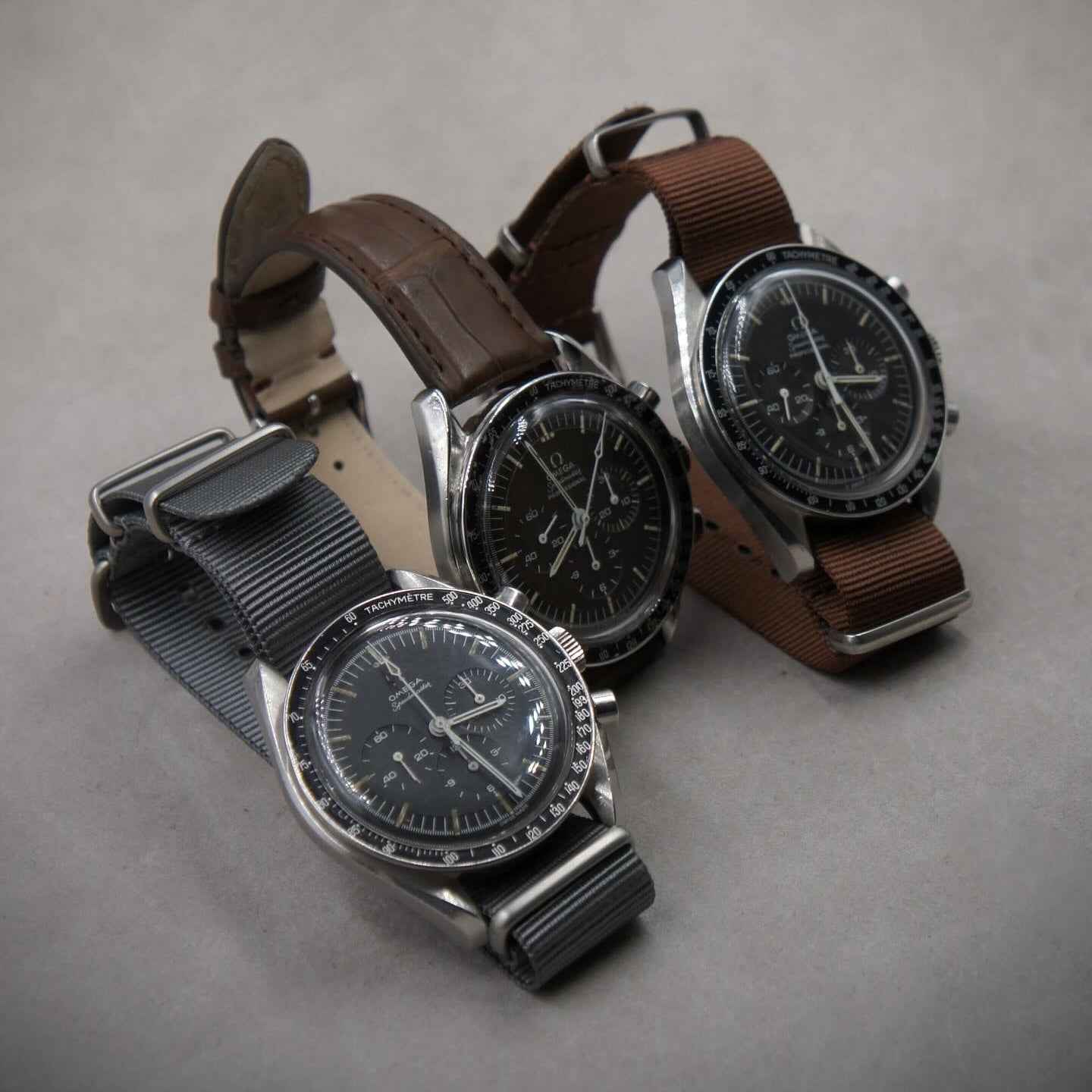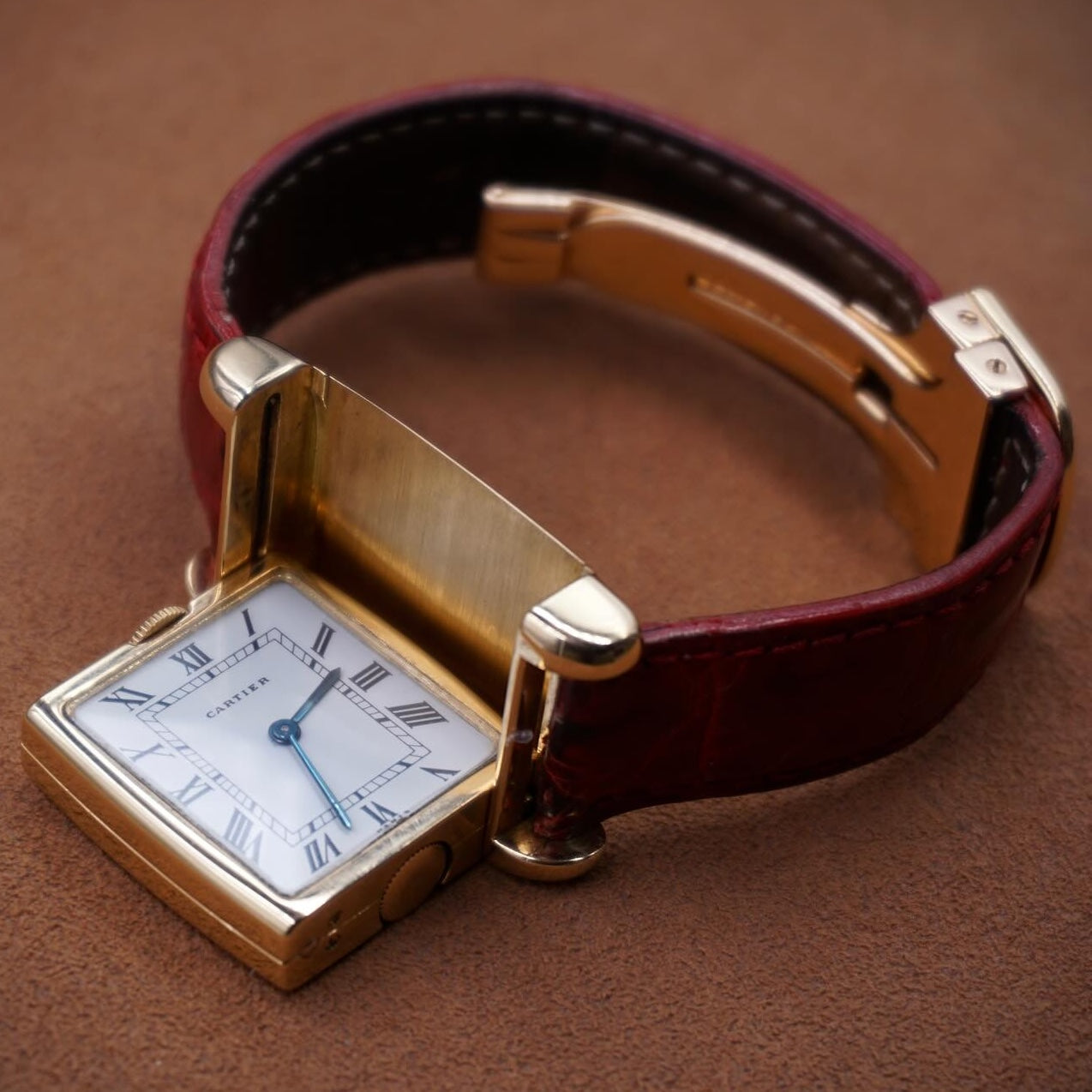The glossary
Contre-Temps' little watchmaking glossary
The hands of a watch are the primary indicators of time, sometimes date and, in the case of a chronograph, elapsed time.
They are placed on a hand axis and visible on the watch face. There are several possible finishes and are listed as follows:
- Baton
- Dauphine
- Snowflakes
- Lance
- Leaf
- Cathedral
This refers to the complication in which a function (hours, minutes, seconds, dates, days of the week, months) is indicated by a hand that, instead of making a 360-degree rotation on its axis, moves over a limited arc or angle, before returning instantly to its starting point once its race is complete. We speak of retrograde hours, retrograde minutes, etc., as the case may be.
The heart of the movement is the organ that regulates the watch. A metal circle that oscillates on its axis of rotation (balance wheel axis) and which, coupled to the "spiral" spring, executes a perfectly regular back-and-forth movement, called oscillation (the famous "tic-tac") and which drives the entire movement of the watch.
The watch case is the casing into which the movement, dial and hands are inserted and which acts as the main protection against shock, humidity and dust.
There are two main types of buckles that fit watch bands:
Folding clasp, most often in metal, single or double, closes the band completely by its fixed attachments, on each side and adapts as well to leather, metal or rubber bands. It allows the watch to stay on the wrist in case of accidental opening.
Pin buckle is the traditional buckle for leather or synthetic bands and is recognizable by the pin which is the piece that penetrates one of the holes in the band, thus allowing the closing and maintenance of the latter on the wrist.
The watch band is the attachment that connects the case on both sides and allows the watch to be held around the wrist. There are 4 main band materials.
Metal band, in Steel, Gold (Yellow, Rose, White), Platinum, etc...
Leather band , for example in Calf, Lizard, Alligator, Ostrich, Shark, etc..
NATO nylon band which owes its original name to its presence in the catalogue of NATO equipment (NATO in English).
Rubber band (mainly for diving watches).
The dial is the plate that occupies the surface of the movement and prominently under the glass to allow reading of the time and other functions represented such as date, power reserve, second time zone, tachometer, etc. Protected by the case and glass, it can be made in an infinite number of materials (metal, stone, synthetic materials, wood, sapphire etc.) and colours. It can be divided into 12 or more rarely 24 hours, the latter being nicknamed the "cosmonaut dial".
The calibre of a watch is the internal part of a watch, the 'skeleton' that generates its movement. Note that there is a difference between the movement and the calibre of a watch. A movement includes all the internal parts of the watch including the calibre.
The case middle is the main part of the case that houses the movement and is generally machined from a block of metal or, more rarely, cast. It is located between the case back and the watch bezel.
Precision watch tested in different positions and under different temperatures, and having obtained an official certificate of functioning, determining the level of precision of time measurement. Among the major certification institutes, you will recognize the COSC (Swiss Official Chronometer Testing Institute), the Poinçon de la Vipère in Besançon and the Swiss Federal Institute of Metrology which issues the Metas certification.
A watch that has a specific function, in addition to its other functions, to measure time from a given start time and triggered by the user. Can have several levels of complications such as the fly back or multiple starts.
In watchmaking, a complication refers to any function for a watch other than the indication of hours, minutes and seconds. In general, the more sophisticated the complication, the rarer the watch. Among the most renowned complications are the chronograph, the perpetual calendar or date, the tourbillon, time zones, or moon phases.
The lugs are the part of the case, generally protruding, and which serve as a support to fix the band to the case middle.
The Cosmograph Daytona was created (1963) to be the best timekeeping tool for racing drivers thanks to its precision and reliability. This watch, equipped with an additional mechanism allowing the measurement and display, by means of additional hands, of a time interval, also offers excellent readability of its functions. The central chronograph seconds hand can measure time to 1/8th of a second; the two counters located at 3 o'clock and 9 o'clock on the dial display the elapsed time in minutes and hours, respectively.
The crown of a watch (also called the winding crown) is the round piece that you turn to wind the watch or set the time and date if available. In addition to its mechanical function, it is one of the visible aesthetic elements of the watch and therefore receives sometimes very careful attention to its creation. The side is generally fluted for easy grip, and the top can be engraved with the brand logo or embellished with a precious stone. It is screwed or pushed and, depending on the case, ensures the water resistance of the watch or not.
The quickset date is a complication that allows direct adjustment of the date without changing the time as on a traditional movement with a date function. This function is generally obtained by pulling the crown out to an intermediate position before the time setting position.
The name of the calibre invented by LeCoultre & Cie in 1925, to reconcile miniaturization and precision. By extension, the Duoplan watch is equipped with a calibre on two levels in order to maintain a balance comparable to calibres of normal dimensions but on a considerably reduced surface. The crown is consequently positioned under the caseback instead of the usual side.
The lug width of a watch case is the distance between the two lugs or horns of a watch. This measurement determines the size of the band that can be used for the watch.
A watch that has been serviced, tested and made watertight for complete immersion in water according to its original specifications. Does not particularly appreciate hot showers!
The flyback is a chronograph function that allows you to measure the duration of an event, stop it and reset it to zero with a single press of a pusher, thus saving precious time. This function was invented for airplane pilots.
The caseback of a watch is the lid that is located on the back of the case and seals it to protect the movement. This caseback can be clipped onto the middle case, or screwed on to improve its water resistance. The caseback can sometimes be transparent and therefore allow you to see the movement of the watch.
The draw-tube stop is a metal piece essential to the movement of the watch, whose function is to hold the winding stem when the crown is pulled out for winding or setting the time. This piece is held in place by the stop screw, which is tiny and can unscrew over time, allowing the winding stem to protrude from the case.
An acronym for "Greenwich Mean Time". This term in watchmaking refers to the function that allows the display of a second time zone on the dial and simultaneously with the local time.
The aperture is a small opening located on the dial under which various possible indications are displayed, such as the date, moon phase, or power reserve.
A technique of engraving applied to the dial or even to a watch case, which allows you to decorate a metal surface with straight or curved symmetrical lines, rendering a very elaborate finish.
Short for watchmaking and which is said among professionals in everything relating to the world of watches and watchmaking.
The jumping hour is a complication where the hour indication is made in an aperture or on a disc visible by a fixed number and whose hour change takes place by a jump of this display every 60 minutes.
The indexes of a watch are the markings used to represent the hours and minutes on the circumference of the dial. They can be made of various materials, including precious materials such as gold or diamonds.
The bezel of a watch is the upper ring, either in steel or ceramic (very rarely in Bakelite) of the watch that surrounds the glass and therefore the dial. Depending on the watch model, the bezel can be fixed or rotate in one direction or the other. When it only turns in one direction, it is called a "unidirectional bezel". All watches have some kind of bezel, whether it is a thin ring around the glass or a measuring piece with numbering and details designed to aid in reading certain functions of the watch.
The name given to the large watchmaking houses (Omega, Rolex, Jaeger-Lecoultre, Patek Philippe, Vacheron-Constantin, Breguet, Longines etc…) as opposed to the major watch design brands often originating from jewellery (Cartier, Bulgari, Chanel, Hermes, Poiray).
A watch storage and carrying device, most often in the form of a leather or fabric pouch that rolls up on itself, designed to carry one or more watches, bands, and sometimes even tools.
A listed name for a homogeneous and recognizable type of watch from a major brand.
Refers to watches whose case offers a protection system against frontal shocks on the glass. The great classics of protected watches are:
- The Reverso by Jaeger-Lecoultre (inventor of the concept) and Cartier
- The Basculante by Cartier
- The Cabriolet Universal and by Cartier
- The Hermeto by Movado
- The Hooded watches by Omega and Jaeger-Lecoultre
This is a general term for a watch that has broken down (or has a significant time difference) following the seizing (thickening and sticking) of the oils necessary for the proper functioning of the movement. Originally, the balance spring became seized when two coils stuck together due to the thickening of oil that had accumulated over the years.
This is a general term for watches deliberately designed to perform specific tasks or functions and highly appreciated by certain professions (pilots, divers, guides, etc.). Beyond a recognizable aesthetic, tool watches are distinguished by their functionality and durability.
At Contre-Temps, a vintage watch is a watch that was previously owned by an enthusiast who decided to part with it and which, with a few exceptions, is no longer part of the manufacturer's catalogue. By definition, the number of units available of this model on the market is therefore limited. The watch can be new and in its box, used or pre-owned, if it is no longer produced it will be considered vintage.
The movement of a watch is the set of internal parts that make up the watch mechanism. The movement includes the calibre. The 3 main types of movements are:
- Mechanical movement with manual winding
- Mechanical movement with automatic winding
- Quartz movement
This refers to a self-winding movement that, under the effect of wrist movement, winds itself "perpetually".
This refers to a dial whose surface is covered with a "honeycomb" motif finish, as you can find on a textile for example.
The unique number of a watch and/or movement specific to each brand. It is the identity number of the watch shown on the warranty or service certificates and registered by the manufacturers.
As the name suggests, a watch that is completely allergic to contact with liquids. This is most often the case for watches over 40 years old. In case of an accident, take the piece to the repair shop as soon as possible.
A moon phase watch is a watch that measures and indicates the different phases of the moon over the lunar month through an opening located on its dial (aperture). This complication of fine watchmaking allows you to know the current phase of the moon - as it appears in the sky where you are located - without direct observation
The spring bars of a watch are the small metal tubes which, by means of an internal spring, are inserted into the two lugs or horns of the case to hold the band in place.
The date complication is the technical term for the mechanism that allows the date to be displayed on the dial of a watch. When perpetual, the date automatically takes into account months of 28, 29, 30 and 31 days and leap years thanks to an advanced complication that acts as a mechanical memory.
The reference number of a watch is generally a numbering system (numbers and letters) used by manufacturers to distinguish different finishes within the same series of watch models. The most famous references can be found, for example, at Rolex to distinguish different finishes on a model like the "Submariner" or "GMT" depending on the material of the glass or the material of the case.
The minute repeater is a complication that allows you to signal the exact time on demand without looking at its dial by means of distinct high and low chimes. It is a complication particularly prized by collectors and considered very difficult to achieve.
The power reserve is the remaining operating time of a watch, without winding it for a mechanical watch or without wearing it for an automatic watch, expressed in hours or days. It is common to have a forty-hour power reserve on a fully wound watch. Some watch models have a complication that displays the remaining power reserve level through an aperture.
This refers to a movement or a caseback. The skeleton is an aesthetic design where certain parts of a watch and the movement have been placed under a transparent protection, opened or arranged to reveal the workings of the watch.
The winding stem is the metal rod that drives the movement to wind the watch (on mechanical watches) or to set the date and time as needed. This winding stem ends with the crown, which allows for a better grip between the fingers.
A precious metal made of solid silver covered with a thin layer of gold. The solid silver is covered with gold by an electrolytic process. It is therefore gold-plated silver. The metal is most often marked with Minerva's head and the letter V.
The watch crystal is the transparent upper part that protects the dial and hands of the watch and also contributes to the partial or total water resistance of the watch. It can be made of various materials:
Glass or mineral crystal: Historically the material used on most vintage watches. Breaks but does not scratch.
Plexiglas or Hesalite: Derived from plastic components highly prized by collectors for the warmer light it lets through on the dial. Does not break, can scratch but can also be polished to regain its transparency.
Sapphire crystal: Historically appeared in the 1980s, it gradually replaced Plexiglas crystals in most major manufactures. Derived from a synthetic sapphire, it offers a high resistance to scratches, superior to Plexiglas, and a shock resistance far superior to mineral glass.
A watch that has been serviced and made watertight for momentary contact with liquid. Would not be resistant to prolonged immersion. Hot showers are absolutely to be avoided!


